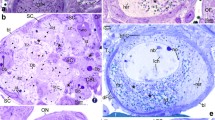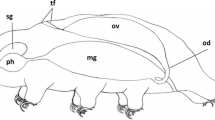Summary
Dinophilus gyrociliatus produces two types of oocytes, a big, female producing “♀-oocyte”, and a smaller, male-producing “♂-oocyte”. They may be distinguished by their different volume from the beginning of the vitellogenic phase. Neither oogonia nor previtellogenic oocytes show two types of cells, and the beginning of differentiation in ♀-oocytes and ♂-oocytes has to be located in a connecting stage after the previtellogenic and before the vitellogenic phase. On previtellogenic stages the cells fuse and form bigger ones, but there is no connection to be found with the differentiation of the egg cells.
The ♂-oocyte starts the production of mucopolysaccharid granules at an early vitellogenic stage; the ♀-oocyte does so only at later stages. These granules form the egg capsule after the eggs have been laid.
The ♀-oocyte contains bigger protein yolk granules than the smaller ♂-oocyte. Already on the connecting stage it is possible to distinguish two groups of cells by the size of their granules.
The ribonucleic acid content in the ♀-oocyte exceeds greatly that of the ♂-oocyte. The RNA-concentration, however, is higher in the latter one. During the vitellogenic stages the rate of RNA-synthesis in either type of oocytes parallels the increase in cell volume, the synthesis lasting up to the end of the vitellogenic phase.
Zusammenfassung
Dinophilus gyrociliatus bildet zwei Oocytentypen, einen größeren, aus dem ♀♀ hervorgehen (♀-Oocyte) und einen kleineren, der sich zu ♂♂ entwickelt (♂-Oocyte). Diese beiden Oocytentypen sind von frühen Stadien der Vitellogenese an durch ihr unterschiedliches Größenwachstum zu unterscheiden. Da bei Oogonien und prävitellogenen Oocyten keine zwei unterschiedlichen Zelltypen festzustellen sind, muß man annehmen, daß die Differenzierung in ♂- und ♀-Oocyten in einem zwischen der Prävitellogenese- und der Vitellogenesephase gelegenen Übergangsstadium beginnt. Während der Prävitellogenesephase finden Zellverschmelzungen statt, aber es konnten keine Beziehungen zwischen der Fusion von Oocyten und der späteren Differenzierung nachgewiesen werden.
Die ♂-Oocyte beginnt schon auf einem frühen Stadium der Vitellogenese mit der Produktion von Mucopolysaccharid-Granula, die ♀-Oocyte erst später. Diese Granula bilden nach der Ablage der Eier die Ei- oder die Kokonhülle.
Die ♀-Oocyte bildet größere Proteindottergranula als die kleinere ♂-Oocyte. Eine Trennung zweier Zellsorten nach Granulagrößen läßt sich schon auf dem Übergangsstadium durchführen. Der absolute RNS-Gehalt der reifen ♀-Oocyte liegt wesentlich über dem der ♂-Oocyte; dagegen ist die Konzentration der RNS in der ♂-Oocyte höher. Die RNS-Synthese verläuft in beiden Oocytentypen parallel zur Volumenzunahme und dauert bis zum Ende der Vitellogenesephase.
Similar content being viewed by others
Literatur
Anderson, E., Huebner, E.: Development of the oocyte and its accessory cells of the polychaete Diopatra cuprea (Bosc.). J. Morph. 126, 163–198 (1968).
Arnold, A.: Histochemie. Berlin-Heidelberg-New York: Springer 1968.
Ax, P.: Das Fortpflanzungsverhalten von Trilobodrilus (Archiannelida, Dinophilidae). Marine Biology 1, 330–335 (1968).
Baker, J. R.: Note on the use of bromophenol blue for the histochemical recognition of protein. Quart. J. micr. Sci. 99, 459–460 (1958).
Bier, K.: Über den Saisondimorphismus der Oogenese von Formica rufa rufopratensis minor Gössw. und dessen Bedeutung für die Kastendetermination. Biol. Zbl. 73, 170–190 (1954).
Brachet, J.: The use of basic dyes and ribonucleases for the cytochemical detection of ribonucleic acid. Quart. J. micr. Sci. 94, 1–10 (1953).
Buchner, P.: Endosymbiosestudien an Schildläusen. I. Stictococcus sjoestedti. Z. Morph. Ökol. Tiere 43, 262–312 (1954).
Deitch, A. D.: Microspectrophotometric study of the binding of the anionic dye, naphthol yellow S, by tissue sections and by purified proteins. Lab. Invest. 4, 324–351 (1955).
Dhainaut, A.: Origine et ultrastructure des formations mucopolysaccharidiques de la zone corticale de l'ovocyte de Nereis diversicolor. J. Microscopie 8, 69–86 (1969).
Drochmans, P.: Morphologie du glycogène. J. Ultrastruct. Res. 6, 141–163 (1962).
Edström, J. E., Grampp, W., Schor, N.: The intracellular distribution and heterogeneity of ribonucleic acid in starfish oocytes. J. biophys. biochem. Cytol. 11, 549–557 (1961).
Fallon, J. F., Austin, C. R.: Fine structure of gametes of Nereis limbata (Ann.) before and after interaction. J. exp. Zool. 166, 225–242 (1967).
Fawcett, D. W.: Changes in the fine structure of the cytoplasmic organelles during differentiation. In: Developmental Cytology. 16th Growth Symposion, ed. D. Rudnick, p. 161–189. New York: The Ronald Press Comp. 1957.
Flax, M. H., Himes, M. H.: Microspectrophotometric analysis of metachromatic staining of nucleic acids. Physiol. Zool. 25, 297–311 (1952).
Hanocq-Quertier, J., Baltus, E., Ficq, A., Brachet, J.: Studies on the DNA of Xenopus laevis oocytes. J. Embryol. exp. Morph. 19, 273–282 (1968).
Kaudewitz, F.: Zur Entwicklungsphysiologie von Daphnia pulex. Wilhelm Roux' Arch. Entwickl.-Mech. Org. 144, 410–447 (1950).
Kessel, R. G.: Intranuclear annulate lamellae in oocytes of the tunicate, Styela partita. Z. Zellforsch. 63, 37–51 (1964).
Kessel, R. G.: Mechanism of protein yolk synthesis and deposition in crustacean oocytes. Z. Zellforsch. 89, 17–38 (1968).
Koch, E. A., King, R. C.: Further studies on the ring canal system of the ovarian cystocytes of Drosophila melanogaster. Z. Zellforsch. 102, 129–152 (1969).
Korschelt, E.: Über Bau und Entwicklung von Dinophilus apatris. Z. wiss. Zool. 37, 315–353 (1882).
Loud, A. V.: A method for the quantitative estimation of cytoplasmic structures. J. Cell Biol. 15, 481–487 (1962).
Malsen, H. v.: Geschlechtsbestimmende Einflüsse und Eibildung des Dinophilus apatris. Arch. mikr. Anat. 69, 1–37 (1906).
Mazia, D., Brewer, P. A., Alfert, M.: The cytochemical staining and measurement of protein with mercuric bromophenol blue. Biol. Bull. 104, 57–67 (1953).
Millonig, G.: Phosphate buffer for OsO4 solution in fixation. J. appl. Physiol. 32, 1637 (1961).
Muckenthaler, F., Mahowald, A.: DNA synthesis in the ooplasm of Drosophila melanogaster. J. Cell Biol. 28, 199–208 (1966).
Nachtsheim, H.: Zytologische und experimentelle Untersuchungen über die Geschlechtsbestimmung bei Dinophilus apatris. Arch. mikr. Anat. 93, 17–140 (1919).
Pelc, S. R.: The stripping film technique of autoradiography. Int. J. appl. Radiat. 1, 172–177 (1956).
Revel, J. P.: Electron microscopy of glycogen. J. Histochem. Cytochem. 12, 104–114 (1964).
Romeis, B.: mikroskopische Technik. München: R. Oldenbourg 1968.
Ruthmann, A.: Methoden der Zellforschung. Stuttgart: Franckhsche Verlagshandlung 1966.
Shearer, C.: The problem of sex determination in Dinophilus gyrociliatus. Part I. The sexual cycle. Quart. J. micr. Sci. 57, 329–371 (1912).
Steedman, H. F.: Alcian blue 8 GS: A new stain for mucin. Quart. J. micr. Sci. 91, 477–479 (1950).
Traut, W.: Eine Mutante mit vergrößerten Männchen-Eiern bei Dinophilus gyrociliatus (Archiannelida). Experientia (Basel) 22, 237–238 (1966).
Traut, W.: Über den Geschlechtsbestimmungsmodus bei Dinophilus. Verh. Dtsch. Zool. Ges. in Innsbruck. Zool. Anz. 33, Suppl. 260–265 (1968).
Traut, W.: Zur Sexualität von Dinophilus gyrociliatus (Archiannelida). I. Der Einfluß von Außenbedingungen und genetischen Faktoren auf das Geschlechtsverhältnis. Biol. Zbl. 88, 469–495 (1969a).
Traut, W.: Zur Sexualität von Dinophilus gyrociliatus (Archiannelida). II. Der Aufbau des Ovars und die Oogenese. Biol. Zbl. 88, 695–714 (1969b).
Traut, W.: Zur Sexualität von Dinophilus gyrociliatus (Archiannelida). III. Die Geschlechtsbestimmung. Biol. Zbl. 89, 137–161 (1970).
Williams, J.: Chemical constitution and metabolic activity of animal eggs. In: The biochemistry of animal development, vol. I,1, ed. R. Weber. London-New York: Academic Press 1965.
Author information
Authors and Affiliations
Additional information
Für die Anregung zu dieser Arbeit und stets weiterführende Anteilnahme bin ich Herrn Prof. Dr. W. Traut zu besonderem Dank verpflichtet. Den Herren Professoren Dr. G. de Lattin(†) und Dr. W. Nachtigall, Saarbrücken, Dr. H. Mergner, Bochum sowie besonders Herrn Prof. Dr. M. Durchon, Lille, danke ich für die Bereitstellung eines Arbeitsplatzes und die Unterstützung der Untersuchungen.
Für die Aufenthalte in Lille standen mir ein Forschungsstipendium der französischen Regierung sowie eine Beihilfe der Gesellschaft der Freunde und Förderer der Universität des Saarlandes zur Verfügung.
Rights and permissions
About this article
Cite this article
Grün, G. Über den Eidimorphismus und die Oogenese von Dinophilus gyrociliatus (Archiannelida). Z.Zellforsch 130, 70–92 (1972). https://doi.org/10.1007/BF00306995
Received:
Issue Date:
DOI: https://doi.org/10.1007/BF00306995




